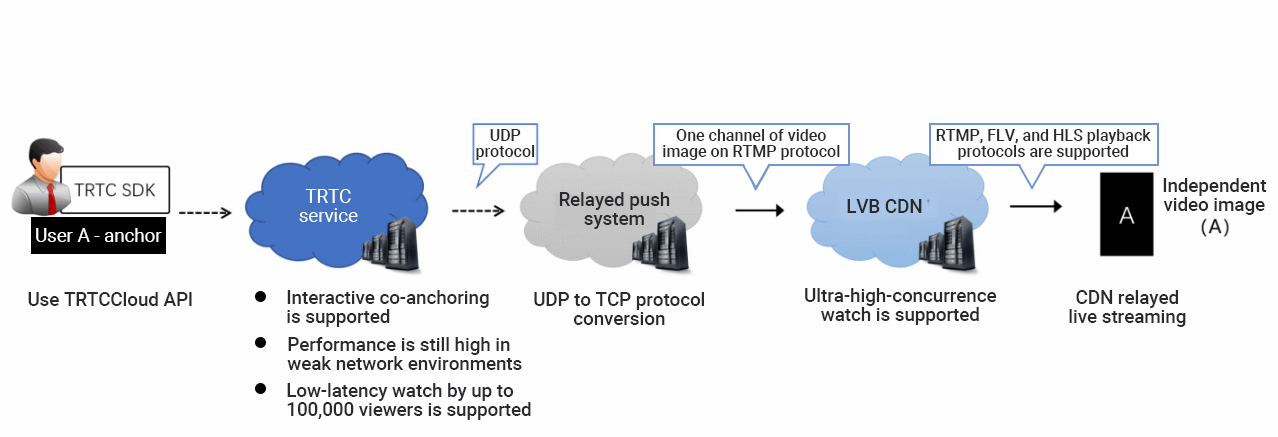实现 CDN 直播观看
最后更新时间:2025-08-14 11:29:15
实现 CDN 直播观看
最后更新时间: 2025-08-14 11:29:15
适用场景
CDN 直播观看,也叫 “CDN 旁路直播”,由于 TRTC 采用 UDP 协议进行传输音视频数据,而标准直播 CDN 则采用的 RTMP\\HLS\\FLV 等协议进行数据传输,所以需要将 TRTC 中的音视频数据旁路到直播 CDN 中,才能在让观众通过直播 CDN 进行观看。
给 TRTC 对接 CDN 观看,一般被用于解决如下两类问题:
问题一:超高并发观看
TRTC 的低延时观看能力,单房间支持的最大人数上限为10万人。CDN 观看虽然延迟要高一些,但支持10万人以上的并发观看,且 CDN 的计费价格更加便宜。
问题二:移动端网页播放
TRTC 虽然支持 WebRTC 协议接入,但主要用于 Chrome 桌面版浏览器,移动端浏览器的兼容性非常不理想,尤其是 Android 手机浏览器对 WebRTC 的支持普遍都很差。所以如果希望通过 Web 页面在移动端分享直播内容,还是推荐使用 HLS(m3u8) 播放协议,这也就需要借助直播 CDN 的能力来支持 HLS 协议。
原理解析
腾讯云会使用一批旁路转码集群,将 TRTC 中的音视频数据旁路到直播 CDN 系统中,该集群负责将 TRTC 所使用的 UDP 协议转换为标准的直播 RTMP 协议。
单路画面的旁路直播
当 TRTC 房间中只有一个主播时,TRTC 的旁路推流跟标准的 RTMP 协议直推功能相同,不过 TRTC 的 UDP 相比于 RTMP 有更强大的弱网络抗性。


混合画面的旁路直播


说明:
为什么不直接播放多路 CDN 画面?
播放多路 CDN 画面很难解决多路画面的延迟对齐问题,同时拉取多路画面所消耗的下载流量也比单独画面要多,所以业内普遍采用云端混流方案。
前提条件
使用步骤
步骤1:开启旁路推流功能
1. 登录 实时音视频控制台。
2. 在左侧导航栏选择应用管理,单击目标应用所在行的功能配置。
3. 在旁路推流配置中,单击启用旁路推流右侧的

步骤2:配置播放域名并完成 CNAME
1. 登录 云直播控制台。
2. 在左侧导航栏选择域名管理,您会看到在您的域名列表新增了一个推流域名,格式为
xxxxx.livepush.myqcloud.com,其中 xxxxx 是一个数字,叫做 bizid,您可以在实时音视频控制台 > 应用管理 > 应用信息中查找到 bizid 信息。3. 单击添加域名,输入您已经备案过的播放域名,选择域名类型为播放域名,选择加速区域(默认为中国大陆),单击确定即可。
4. 域名添加成功后,系统会为您自动分配一个 CNAME 域名(以
.liveplay.myqcloud.com为后缀)。CNAME 域名不能直接访问,您需要在域名服务提供商处完成 CNAME 配置,配置生效后,即可享受云直播服务。具体操作请参见 CNAME 配置。注意:
不需要添加推流域名,在 步骤1 中开启旁路直播功能后,腾讯云会默认在您的云直播控制台中增加一个格式为
xxxxx.livepush.myqcloud.com 的推流域名,该域名为腾讯云直播服务和 TRTC 服务之间约定的一个默认推流域名,暂时不支持修改。步骤3:关联 TRTC 的音视频流到直播 streamId
开启旁路推流功能后, TRTC 房间里的每一路画面都配备一路对应的播放地址,该地址的格式如下:
http://播放域名/live/[streamId].flv
地址中的 streamId 可以在直播中唯一标识一条直播流,您可以自己指定 streamId,也可以使用系统默认生成的。
方式一:自定义指定 streamId
您可以在调用
TRTCCloud 的 enterRoom 函数时,通过其参数 TRTCParams 中的 streamId 参数指定直播流 ID。
以 iOS 端的 Objective-C 代码为例:TRTCCloud *trtcCloud = [TRTCCloud sharedInstance];TRTCParams *param = [[TRTCParams alloc] init];param.sdkAppId = 1400000123; // TRTC 的 SDKAppID,创建应用后可获得param.roomId = 1001; // 房间号param.userId = @"rexchang"; // 用户名param.userSig = @"xxxxxxxx"; // 登录签名param.role = TRTCRoleAnchor; // 角色:主播param.streamId = @"stream1001"; // 流 ID[trtcCloud enterRoom:params appScene:TRTCAppSceneLIVE]; // 请使用 LIVE 模式
方式二:系统指定 streamId
开启自动旁路推流后,如果您没有自定义指定 streamId,系统会默认为您生成一个缺省的 streamId,生成规则如下:
拼装 streamId 用到的字段
SDKAppID:您可以在 控制台 >【应用管理】>【应用信息】中查找到。
bizid:您可以在 控制台 >【应用管理】>【应用信息】中查找到。
roomId:由您在
enterRoom 函数的参数 TRTCParams 中指定。userId:由您在
enterRoom 函数的参数 TRTCParams 中指定。streamType: 摄像头画面为 main,屏幕分享为 aux (WebRTC 由于同时只支持一路上行,因此 WebRTC 上屏幕分享的流类型是 main)。
拼装 streamId 的计算规则
拼装 | 2020年01月09日及此后新建的应用 | 2020年01月09日前创建且使用过的应用 |
拼装规则 | streamId = urlencode(sdkAppId_roomId_userId_streamType) | StreamId = bizid_MD5(roomId_userId_streamType) |
计算样例 | 例如:sdkAppId = 12345678,roomId = 12345,userId = userA,用户当前使用了摄像头。那么:streamId = 12345678_12345_userA_main | 例如:bizid = 1234,roomId = 12345,userId = userA,用户当前使用了摄像头。那么:streamId = 1234_MD5(12345_userA_main) = 1234_8D0261436C375BB0DEA901D86D7D70E8 |
步骤4:控制多路画面的混合方案
如果您想要获得混合后的直播画面,需要调用 TRTCCloud 的
setMixTranscodingConfig 接口启动云端混流转码,该接口的参数 TRTCTranscodingConfig 可用于配置:各个子画面的摆放位置和大小。
混合画面的画面质量和编码参数。
注意:
setMixTranscodingConfig 并不是在终端进行混流,而是将混流配置发送到云端,并在云端服务器进行混流和转码。由于混流和转码都需要对原来的音视频数据进行解码和二次编码,所以需要更长的处理时间。因此,混合画面的实际观看时延要比独立画面的多出1s - 2s。步骤5:获取播放地址并对接播放
http://播放域名/live/[streamId].flv
例如,您的播放域名为
live.myhost.com,您将房间(1001)中的用户 userA 的直播流 ID 通过进房参数指定为 streamId = "streamd1001"。
则您可以得到三路播放地址:rtmp 协议的播放地址:rtmp://live.myhost.com/live/streamd1001flv 协议的播放地址:http://live.myhost.com/live/streamd1001.flvhls 协议的播放地址:http://live.myhost.com/live/streamd1001.m3u8
我们推荐以
http 为前缀且以 .flv 为后缀的 http - flv 地址,该地址的播放具有时延低、秒开效果好且稳定可靠的特点。
播放器选择方面推荐参考如下表格中的指引的方案:步骤6:优化播放延时
开启旁路直播后的 http - flv 地址,由于经过了直播 CDN 的扩散和分发,观看时延肯定要比直接在 TRTC 直播间里的通话时延要高。
按照目前腾讯云的直播 CDN 技术,如果配合 TXLivePlayer 播放器,可以达到下表中的延时标准:
旁路流类型 | TXLivePlayer 的播放模式 | 平均延时 | 实测效果 |
独立画面 | 极速模式(推荐) | 2s - 3s | 下图中左侧对比图(橙色) |
混合画面 | 极速模式(推荐) | 4s - 5s | 下图中右侧对比图(蓝色) |
如果您在实测中延时比上表中的更大,可以按照如下指引优化延时:
使用 TRTC SDK 自带的 TXLivePlayer
普通的 ijkplayer 或者 ffmpeg 基于 ffmpeg 的内核包装出的播放器,缺乏延时调控的能力,如果使用该类播放器播放上述直播流地址,时延一般不可控。TXLivePlayer 有一个自研的播放引擎,具备延时调控的能力。
设置 TXLivePlayer 的播放模式为极速模式
可以通过设置 TXLivePlayerConfig 的三个参数来实现极速模式,以 iOS 为例。
以 iOS 端的 Objective-C 代码为例:
// 设置 TXLivePlayer 的播放模式为极速模式TXLivePlayerConfig * config = [[TXLivePlayerConfig alloc] init];config.bAutoAdjustCacheTime = YES;config.minAutoAdjustCacheTime = 1; // 最小缓冲1sconfig.maxAutoAdjustCacheTime = 1; // 最大缓冲1s[player setConfig:config];// 启动直播播放
相关费用
注意:
观看费用:通过直播 CDN 观看时产生的费用
转码费用:启用多路画面混合时收取
如果您启用了 多路画面混合 ,混流需要进行解码和编码,因此会产生额外的混流转码费用。混流转码根据分辨率大小和转码时长进行计费,主播用的分辨率越高,连麦时间(通常在连麦场景才需要混流转码)越长,费用越高,详情请参见 云直播 > 直播转码 计费说明。
例如,您通过 setVideoEncodrParam() 设置主播的码率(videoBitrate)为1500kbps,分辨率为720P。如果有一位主播跟观众连麦了1个小时,连麦期间开启了 多路画面混合 ,那么产生的转码费用为
0.0057美元/分钟 × 60分钟 = 0.342美元。常见问题
为什么房间里只有一个人时画面又卡又模糊?
请将
enterRoom 中 TRTCAppScene 参数指定为 TRTCAppSceneLIVE。
VideoCall 模式针对视频通话做了优化,所以在房间中只有一个用户时,画面会保持较低的码率和帧率以节省用户的网络流量,看起来会感觉又卡又模糊。文档反馈
